Canon EOS Digital Rebel XT (350D) Hands on Review
by Bob Atkins
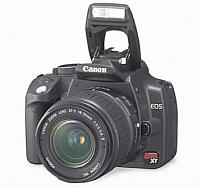
First, photo.net would like to thank ADORAMA for making a (EOS 350D) available us for review.
This will be a very preliminary assessment of the Digital Rebel XT. I know a lot of people are waiting for a hands-on review and a comparison with the EOS 20D so rather than wait until I've finished all the testing, analyzed the results and written the article (which may take a week or so), I thought I'd present some of my early finding now, then add to this article when the review process is complete.
Initial Impressions
It's small. I know the specifications give you the size, but there's nothing like picking up the camera and holding it. In fact for me it's on the verge of being too small. Now I'm a 6ft male, so my hands are, I guess, fairly large. If I was a 5ft female, maybe the size would be perfect. The image below shows the Digital Rebel XT compared to several other cameras:
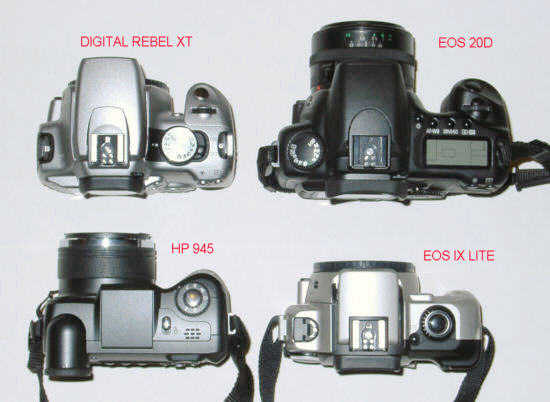
As you can see, it's significantly smaller than the EOS 20D. It's almost hard to hold in my right hand. It's comparable in size to the HP945 digicam and the old Canon IX lite APS (film) camera. The Digital Rebel is 4.98" x 3.71" x 2.63", the EOS 20D is 5.7" x 4.2" x 2.8".
It feels less "sturdy" than the EOS 20D. Part of this I'm sure is due to it being lighter. It's also finished in slightly rough hard plastic. The 20D has a softer rubberized finish in the grip areas, which is easier to hold. Looking through the viewfinder it's evident that the image is pretty small. The illustration below gives you some idea of the relative sizes of the viewfinder image in the EOS-3, EOS 20D and Digital Rebel XT:
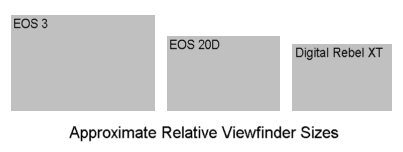
Some people don't like small viewfinders, but personally I could live with it. Sure it's smaller, and larger would be nice, but it's by no means a deal breaker for me.
Operationally the major differences between the 20D are in terms of convenience and ergonomics rather than functionality. For example setting flash exposure compensation is done on the EOS 20D using a button and control dial. On the Digital Rebel XT it is done by going into the menu, selecting the appropriate page, scrolling down to the appropriate entry, hitting "set", selecting the amount of compensation using the scrolling buttons and hitting the "set " button again. Both work, but making changes is faster and easier on the 20D. Actually in one case the use of the menu turns out to be an advantage though. Setting white balance on the Digital Rebel XT is done via the menu screen, and the options are given as symbols with descriptive text. With the 20D you set WB via a button and control dial, but the display is on the data LCD and all you see is a tiny symbol, which is not only difficult to make out, but remembering which symbol corresponds to which WB setting!
The cursor buttons also act as dedicated buttons for ISO, AF, WB and metering mode. You press one of the buttons, it brings up the menu screen, you select the option with either the control dial or the cursor buttons, then you have to remember to push "SET". If you don't push "SET", the new setting will not take effect - and you won't know it hasn't unless you check on the data LCD or in the appropriate menu.
The menu screen of the Digital Rebel XT is a little harder to see in daylight than that of the 20D due to the structure. The Digital Rebel XT uses a "Powershot" style menu with 5 selectable pages. However the page text is somewhat "grayed out" in a low contrast mode until the cursor is moved onto the page. The 20D uses a longer, scrolling menu screen, but all the entries are at full contrast all the time.
Another XT/20D difference is in the battery charger. The Rebel XT charger glows red while charging and green when charged. The EOS 20D charger shows the state of the charge in 4 levels by means of flashing LEDs. No big deal, they both charge batteries, but the 20D charger does does it with more user feedback. Since the battery used in the Digital Rebel XT is the same as that used in many of the lower priced "Powershot" digicams, I assume the same (less expensive) battery charger is used. It works fine of course.
The shutter noise of the XT is lower and less "harsh" than that of the 20D. Since I can think of no reason anyone would want a louder shutter, score one for the Digital Rebel XT! However the 20D shutter is faster, has a higher sync speed, has less viewfinder blackout time and a shorter lag time, so you are trading off noise for performance.
Image Quality
What I'm sure many people want to know most is how the image quality of the Digital Rebel XT compares to that of the EOS 20D. Well, I had a chance to shoot a couple of comparison shots at ISO 100 and a couple at ISO 1600. Both cameras were set to the same parameter set (set 2, all setting "normal") and the same lens was used. Lighting was normal outdoor daylight.
My conclusion from looking at these few images is that image quality is very very close. In fact I really couldn't see any significant difference in terms of sharpness or noise levels, even at 200% in PhotoShop. I'm not saying there's no difference (yet). I haven't done any scientific testing. What I'm saying is that if there is a difference, it was to small for me to see based on "normal" shots of a "normal" subject. Maybe shooting resolution test targets and gray cards I'll see some difference, but I really don't expect I will.

Above are sample crops at 100% from the images. The top row were shot at ISO 1600, the bottom row at ISO 100. Can you tell the difference between camera "A" and camera "B"? One is the EOS 20D and the other is the Digital Rebel XT. If there's enough of a difference for you to worry about, the you're too picky! However as I said, these are preliminary results, shot with autoexposure and auto color balance. I'll be doing tests under different lighting conditions and looking in more detail at the noise. You can't draw hard conclusions from two shots, but you can get a pretty good idea of what those conclusions are likely to be.
Preliminary Conclusions
It looks very much like the image quality of the Digital Rebel XT is up to that of the EOS 20D. It's also evident from using the Digital Rebel, that it's a Rebel, i.e. a camera aimed at the consumer entry level, while the 20D is clearly aimed at the more experienced and serious photographer. Ultimately in many respects the cameras will be capable of yielding almost identical results, it's just that doing it with the 20D will be a little easier. Of course there are things the Digital Rebel doesn't do as well. It has a slower frame rate, a smaller JPEG image buffer, a lower capacity battery, the AF system is different and, as mentioned, the viewfinder is smaller. However for many people saving $400-$500 will make up for all those things. Personally, I'd buy the 20D, but that's just me. Many people will buy the Digital Rebel XT and be very happy with it.
As I said, I will add more details to this review when I've had a chance to test the camera a little more, but I wanted to give you at least a "first impression".
Update #1
Quite a few people have commented on the difference in shutter sound of the Digital Rebel XT and EOS 20D. Below are plots of the recorded audio of each shutter.
If you click on the links you should hear a sequence of 4 shutter firings for each camera. They were recorded with the microphone about 2" behind the camera. [Note: these are 250KB .wav files]
Update #2
Here's a set of images showing noise levels at various ISO settings, from 100-1600 for the Digital Rebel XT and from 100-3200 for the EOS 20D. These are shots of a gray card and each is a 100% crop from the center of the image.

As you can see, noise levels are very similar. If there are differences, they're too small to matter.
Below are two shots which are 200% crops from the center of the image of a resolution test chart, shot with a Canon EF 300/4L at f8.

It's pretty clear that there's no significant difference in resolution between the 8.2MP EOS 20D and the 8MP Digital Rebel XT.
Update #3
I checked the frame rate on the Digital Rebel XT to see if it met the Canon spec of 3 frames/second. Below are the first and last shots of a 9 frame burst (large/fine JPEGS). That's as much as the XT buffer holds.

As you can see the 9 frames took just about 3 seconds, so it does indeed shoot at 3 frames/second.
Update #4
The image below shows the white balance under tungsten and fluorescent lighting for both the EOS 20D and Digital Rebel XT. These are crops of a shot of a Kodak 18% gray card.
 The bar below the images shows what a theoretical 18% grey patch should look like. The small numbers in white are the Red, Green and Blue (RGB) intensity values. As you can see neither camera gets it quite right under any of the white balance settings! All Canon cameras seem to bias towards red/yellow for tungsten in both AWB and Tungsten modes. Some have suggested that this is because people expect indoor shots under Tungsten lighting to be a little red/yellow, so Canon built in that bias. The best neutral performance is shown by the 20D using AWB under fluorescent lighting.
The bar below the images shows what a theoretical 18% grey patch should look like. The small numbers in white are the Red, Green and Blue (RGB) intensity values. As you can see neither camera gets it quite right under any of the white balance settings! All Canon cameras seem to bias towards red/yellow for tungsten in both AWB and Tungsten modes. Some have suggested that this is because people expect indoor shots under Tungsten lighting to be a little red/yellow, so Canon built in that bias. The best neutral performance is shown by the 20D using AWB under fluorescent lighting.
The images below show the same gray card shot under daylight illumination from a cloudy sky.
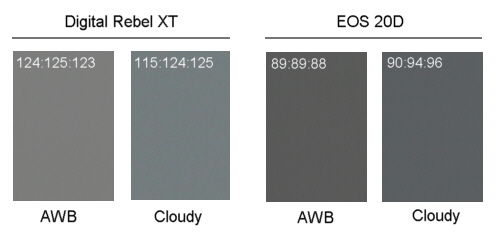 Again there are differences, but they are not so noticeable. In both cases, Auto WB does a slightly better job than selecting Cloudy white balance. The aim is for all three numbers to be the same (which is what makes a neutral gray). It's noticeable that the Digital Rebel XT images in all these tests are slightly lighter than those from the 20D. In theory, a shot of an 18% gray card in sRGB color space (gamma=1.8) should be RGB 117:117:117.
Again there are differences, but they are not so noticeable. In both cases, Auto WB does a slightly better job than selecting Cloudy white balance. The aim is for all three numbers to be the same (which is what makes a neutral gray). It's noticeable that the Digital Rebel XT images in all these tests are slightly lighter than those from the 20D. In theory, a shot of an 18% gray card in sRGB color space (gamma=1.8) should be RGB 117:117:117.
Note that in all cases and under any given lighting, if you use the custom white balance function you will get a neutral color balance, by definition. You shoot a gray (or white) card under the desired lighting and use that as a reference. This results in similar shots of the gray (or white) card being exactly neutral.
The next two shots are the exact same scene shot with the Digital Rebel XT and the EOS 20D so you can see what a somewhat neglected lawn looks like in the rain! White balance was set to auto.
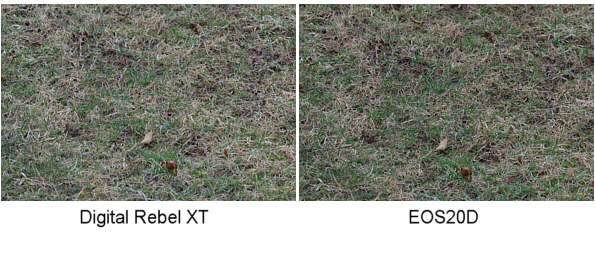 As you can see, on a real world image (rather than a gray card), color balance looks similar (I'd say slightly magenta). The 20D shot is still a little darker. If you convert both images to grayscale, then average the whole image, the average RGB value of the XT image is 108, that of the 20D image is 98 so in this case both meter slightly darker than 18% gray (117) on this scene.
As you can see, on a real world image (rather than a gray card), color balance looks similar (I'd say slightly magenta). The 20D shot is still a little darker. If you convert both images to grayscale, then average the whole image, the average RGB value of the XT image is 108, that of the 20D image is 98 so in this case both meter slightly darker than 18% gray (117) on this scene.
Both look better with slight level and color tweaks though, as shown below:
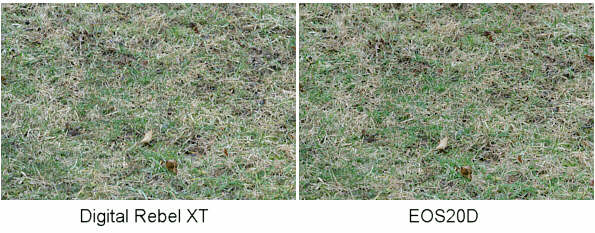
In these and other "real world" exposure tests I saw the 20D give, on average, about 1/3 stop less exposure than the Digital Rebel XT. This is with both cameras using exactly the same lens at the same aperture and the same parameter sets and other settings, and it was independent of metering mode (evaluative, partial etc.). This appears to be due to metering differences, not ISO differences, since at a given aperture the 20D seems to select a shutter speed about 1/3 stop slower. Whether you regard this as a defect or a feature could, I guess, depend on your point of view. The 20D images are a little darker - on the other hand they give you 1/3 stop more "headroom" for highlights under default conditions. Whether this difference is intrinsic to the camera metering algorithms and was designed that way by Canon or simply represents sample to sample variation in these two particular cameras, I don't know since I only have one sample of each to test.
I don't currently have the ability to check or compare color accuracy in any scientific way (maybe soon though!). I can say that the XT and 20D seem pretty similar in normal use on normal subjects in normal lighting. I've been using the 20D for a while now and have had no real color problems, so I'd expect the same to be true for the Digital Rebel XT.
Update #5 - Infra Red
While no DSLR is specified for IR use, many people are using them for IR work. Sensitivity isn't high and exposures are long, but I have seen some pretty good examples shot with cameras like the 20D and Digital Rebel.
Below is a comparison of shots taken with the EOS 20D and Digital Rebel XT using a Hoya R72 filter. This blocks most visible light and allows most IR over 720nm to pass. There wasn't a lot of IR around for these shots. Conditions were overcast.
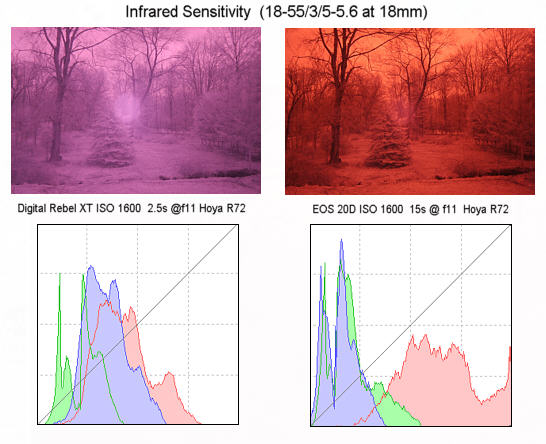 There are a couple of things worthy of comment. First, to get roughly comparable image brightness the Digital Rebel XT needed an exposure of 2.5s when the EOS 20D needed 15s, so the Digital Rebel XT seems more sensitive to IR. However this may not be as good as it seems. As you can see from the histograms, the Digital Rebel XT's blue and red pixels seem to respond to whatever gets through the R72 filter, while in the EOS 20D most response seems to come from the red pixles. Whether this results in lower contrast is hard to say, but the XT's image is lower in contrast than that of the 20D. Note these histograms are for images taken using Auto White Balance. However the same general conclusions hold true for the various fixed white balance options. Using custom white balance is a better option, but since it uses an image shot with the camera as a reference, channel response differences cancel out, so it's not the best option if you wantto know what's going on!
There are a couple of things worthy of comment. First, to get roughly comparable image brightness the Digital Rebel XT needed an exposure of 2.5s when the EOS 20D needed 15s, so the Digital Rebel XT seems more sensitive to IR. However this may not be as good as it seems. As you can see from the histograms, the Digital Rebel XT's blue and red pixels seem to respond to whatever gets through the R72 filter, while in the EOS 20D most response seems to come from the red pixles. Whether this results in lower contrast is hard to say, but the XT's image is lower in contrast than that of the 20D. Note these histograms are for images taken using Auto White Balance. However the same general conclusions hold true for the various fixed white balance options. Using custom white balance is a better option, but since it uses an image shot with the camera as a reference, channel response differences cancel out, so it's not the best option if you wantto know what's going on!

Of course IR images are usually converted into black and white (as shown above), and with enough manipulation both image can be made to look similar, though the XT's image needs stronger corrections Note the central "hotspot" in the XT's image. This is a phenomenon which has been observed with many DLSRs and which depends on the lens in use. Some "hotspot" much more than others. It appears to be due to some sort of back reflection from the surface of the sensor or sensor filters interacting with the lens. Whatever the cause, it seems to be significantly worse for the XT than for the 20D. So from these tests it seems that though the sesitivity of the XT to IR is higher (and exposure times therefore shorter), the intrinsic image quality (contrast) is lower and the hotspot sensitivity is higher. |